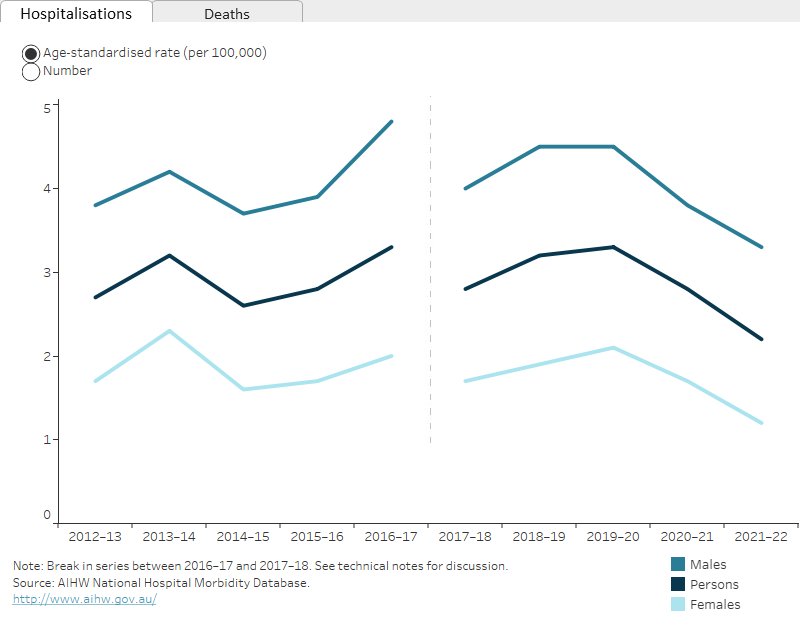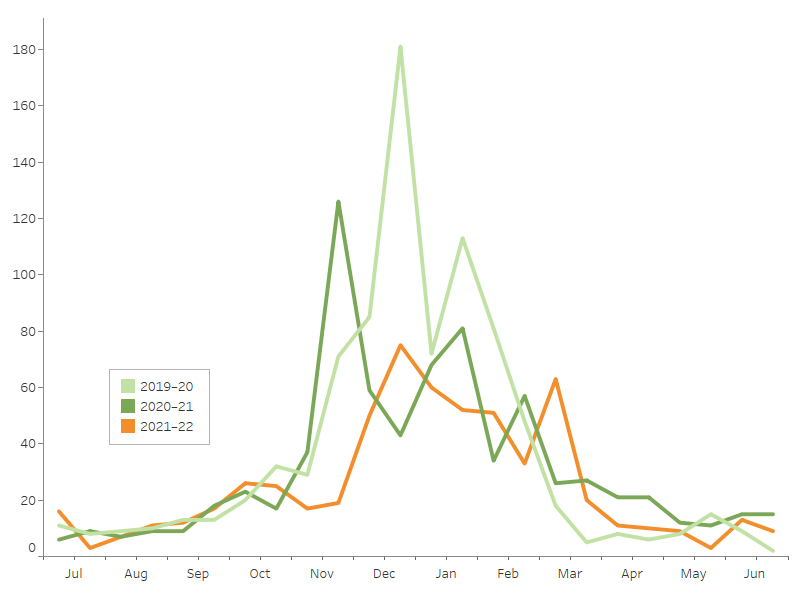For more detail, see Data tables A1–3 and D1–3.
There are many ways that the severity, or seriousness, of an injury can be assessed. Some of the ways to measure the severity of hospitalised injuries are:
- number of days in hospital
- time in an intensive care unit (ICU)
- time on a ventilator
- in-hospital deaths.
The average number of days in hospital for injuries due to exposure to forces of nature and the rate of in-hospital deaths were lower than the average for all hospitalised injuries in 2021–22. The percentage of cases involving a stay in ICU and the percentage involving continuous ventilatory support were higher than the average (Table 3).
Table 3: Severity of hospitalised injuries, 2021–22| | Exposure to forces of nature | All injuries |
|---|
Average number of days in hospital | 3.5 | 4.7 |
% of cases with time in an ICU | 3.1 | 2.0 |
% of cases involving continuous ventilatory support | 2.7 | 1.1 |
In-hospital deaths (per 1,000 cases) | 0.0 | 5.9 |
Note: Average number of days in hospital (length of stay) includes admissions that are transfers from 1 hospital to another or transfers from 1 admitted care type to another within the same hospital, except where care involves rehabilitation procedures.
Source: AIHW National Hospital Morbidity Database.
For more detail, see Data tables A13–15.
In 2021–22, among Aboriginal and Torres Strait Islander people:
- there were 52 injury hospitalisations (Table 4) and less than 5 deaths due to exposure to forces of nature.
Table 4: Hospitalisations due to forces of nature, by sex, Indigenous Australians, 2021–22 | Males | Females | Persons |
|---|
Number | 44 | 8 | 52 |
Rate (per 100,000) | 10 | n.p. | 5.9 |
Note: Rates are crude per 100,000 population.
Source: AIHW National Hospital Morbidity Database.
Indigenous and non-Indigenous Australians
In 2021–22, Indigenous Australians, compared with non-Indigenous Australians, were 3.6 times as likely to be hospitalised due to exposure to forces of nature (Table 5).
Table 5: Age-standardised rates of hospitalisation due to forces of nature, by Indigenous status, 2021–22 | Hospitalisations (per 100,000) |
|---|
Indigenous Australians | 7.5 |
|---|
Non-Indigenous Australians | 2.1 |
|---|
Notes
- Rates are age-standardised per 100,000 population.
- ‘Non-Indigenous Australians’ excludes cases where Indigenous status is missing or not stated.
Source: AIHW National Hospital Morbidity Database and National Mortality Database.
For more detail, see Data tables A4–6 and D4–6.
In 2021–22, people living in Remote areas were more likely to be hospitalised due to forces of nature than those in major cities or inner regional areas (Table 6). Hospitalisation rates increased with increasing remoteness from major cities.
Deaths are not compared here due to low numbers.
Table 6: Age-standardised rates (per 100,000) of hospitalisation due to exposure to forces of nature, by remoteness, 2021–22| | Hospitalisations (per 100,000) |
|---|
Major cities | 1.6 |
Inner regional | 2.2 |
Outer regional | 6.5 |
Remote | 9.4 |
Very remote | n.p. |
Note: Rates are age-standardised per 100,000 population.
Source: AIHW National Hospital Morbidity Database.
People aged 45–64 living in Remote areas had the highest rate of injury hospitalisation due to forces of nature (Figure 4).



 620 hospitalisations in 2021–22
620 hospitalisations in 2021–22 60 deaths in 2020–21
60 deaths in 2020–21


